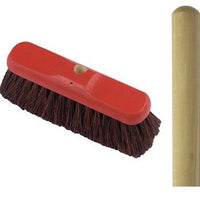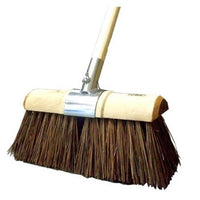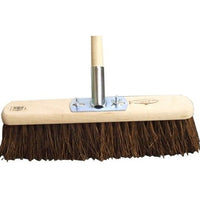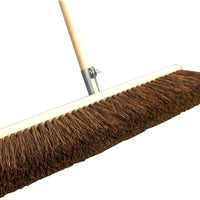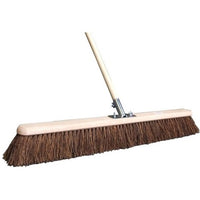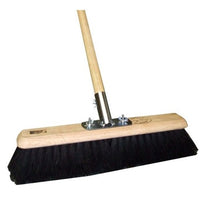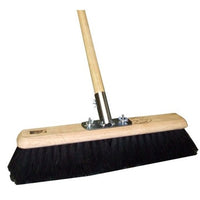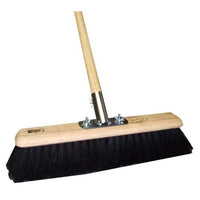Collection: Brooms and Brushes
Comprehensive range of professional brooms and sweeping equipment designed for efficient cleaning across domestic and commercial applications. Featuring traditional bassine brooms for outdoor use, platform brooms for large area sweeping, soft bristle brooms for delicate surfaces, stiff bristle brooms for heavy-duty cleaning, colour-coded Abbey hygiene systems for contamination control, and specialist yard brooms for outdoor maintenance. Essential equipment for facilities management, cleaning services, and domestic cleaning requiring superior sweeping performance.
Brooms and Brushes Product information
ClickCleaning stocks a large range of brooms, ranging from 11" to 36", and designed for domestic or professional use, both indoors and outdoors. For larger areas and lobbies, we also stock various sized dust control and V-sweepers.
Effective sweeping requires selecting appropriate broom types that match surface conditions, debris characteristics, and operational requirements. Modern broom technology combines traditional materials with advanced construction methods to deliver superior cleaning performance whilst addressing hygiene, durability, and efficiency concerns across diverse applications.
At ClickCleaning, we provide a comprehensive range of professional brooms and sweeping equipment designed to meet varied cleaning requirements across all environments. Our carefully selected range includes Stiff Bassine Brooms from 11" to 36" for outdoor and heavy-duty applications, Soft Platform Brooms for delicate surface cleaning, Abbey Washable Colour-Coded Systems for professional hygiene control, Yard Brooms for outdoor maintenance, and Deck Scrubs for specialist cleaning applications.
The selection of appropriate broom types depends on understanding the relationship between bristle materials, surface types, and debris characteristics. Stiff bristles excel at removing heavy debris and cleaning textured surfaces, whilst soft bristles provide gentle cleaning for polished surfaces and fine particle removal. The broom head size affects coverage area and maneuverability, with larger heads improving efficiency on open areas whilst smaller heads enable precision cleaning in confined spaces.
Stiff Bassine Brooms represent traditional sweeping technology optimised for demanding outdoor and heavy-duty cleaning applications. Bassine bristles are derived from palm leaf stems, creating naturally stiff fibres that maintain their shape and effectiveness throughout extended use on rough surfaces and
heavy debris.
The 11" Stiff Bassine Broom provides precision cleaning capability for detailed outdoor work, confined spaces, and applications where manoeuvrability is essential. The compact size enables effective cleaning around obstacles whilst maintaining the scrubbing power necessary for stubborn debris removal.
Yard Brooms in 13" size bridge the gap between detail and area cleaning, providing optimal balance between coverage and control for general outdoor maintenance. The size suits most domestic and light commercial applications whilst maintaining the stiff bristle characteristics essential for effective outdoor sweeping.
Platform Brooms in 18", 24", and 36" sizes deliver maximum efficiency for large area sweeping applications. The platform design creates extended bristle contact with the surface, enabling rapid debris removal across substantial areas whilst maintaining consistent cleaning pressure.
The 18" Platform Broom suits medium-area applications including walkways, small courtyards, and commercial entrances. The size provides good coverage whilst remaining manageable for extended use, making it ideal for routine maintenance cleaning.
The 24" Platform Broom optimises efficiency for larger areas including car parks, warehouse floors, and substantial outdoor spaces. The increased width significantly reduces cleaning time whilst maintaining the stiff bristle performance necessary for heavy debris removal.
The 36" Platform Broom represents maximum efficiency for very large areas including loading bays, sports facilities, and industrial outdoor spaces. The substantial width enables rapid cleaning of extensive areas, though the size requires adequate physical capability for effective operation.
Stiff bassine construction throughout the range ensures consistent performance on rough surfaces including concrete, asphalt, and textured paving. The natural bristle material provides excellent durability whilst maintaining the flexibility necessary for effective surface contact on uneven terrain.
Soft Platform Brooms address applications requiring gentle cleaning action on delicate surfaces or fine particle removal. The soft bristle construction prevents surface damage whilst providing effective cleaning performance on polished floors, sealed surfaces, and areas where harsh scrubbing would be
inappropriate.
The 18" Soft Platform Broom provides gentle cleaning for medium areas including indoor commercial spaces, polished concrete floors, and sealed
surface applications. The soft bristles effectively capture fine debris whilst preventing scratching or damage to sensitive surfaces.
The 24" Soft Platform Broom extends gentle cleaning capability to larger areas including retail floors, office spaces, and areas requiring frequent maintenance cleaning. The increased width improves efficiency whilst maintaining the gentle cleaning action essential for delicate surfaces.
The 36" Soft Platform Broom delivers maximum efficiency for large delicate surface areas including sports halls, exhibition spaces, and commercial facilities with polished floors. The substantial width enables rapid cleaning whilst the soft bristles ensure surface protection.
Soft bristle construction utilises synthetic materials that provide consistent performance and hygiene advantages over natural materials. The synthetic fibres resist bacterial growth whilst maintaining their cleaning effectiveness through multiple cleaning cycles.
Abbey Washable Colour-Coded Systems represent advanced hygiene technology that addresses contamination control requirements in professional cleaning environments. These systems combine effective cleaning performance with visual identification systems that prevent cross-contamination between different cleaning areas.
The 12" Abbey Washable Brooms in both soft and stiff configurations provide compact cleaning capability with full colour-coding benefits. Available in blue and green colours, these brooms enable precise cleaning whilst maintaining contamination control protocols.
Blue colour designation typically indicates general cleaning areas including offices, reception areas, and public spaces. The colour-coding ensures that brooms used in these areas never cross-contaminate with food preparation or high-risk areas.
Green colour designation indicates food preparation and kitchen areas where maintaining hygiene standards is paramount. The dedicated green equipment ensures that contamination cannot transfer from other areas to food preparation zones.
The 18" Abbey Washable Brooms extend colour-coded capability to medium-area applications whilst maintaining the hygiene advantages of washable
construction. The larger size improves efficiency for commercial cleaning whilst preserving contamination control benefits.
Washable construction enables thorough cleaning and sanitisation of broom heads through machine washing at temperatures up to 100°C. This capability ensures that bacterial contamination is eliminated whilst extending broom life through proper maintenance.
The 9" Deck Scrubs provide specialist cleaning capability for detailed scrubbing applications. The compact size and robust construction suit applications requiring aggressive cleaning action in confined spaces or detailed work around fixtures and fittings.
Stiff bristle construction in deck scrubs provides maximum scrubbing power for removing stubborn soils, stains, and adherent debris. The aggressive
cleaning action suits applications including grout cleaning, textured surface maintenance, and preparation work.
Handle compatibility across the range ensures that broom heads can be used with appropriate handle systems for optimal ergonomics and efficiency. Proper handle selection affects operator comfort, cleaning effectiveness, and equipment longevity.
Wooden handles provide traditional feel and durability for outdoor applications whilst remaining cost-effective for high-volume operations. The natural material provides good grip characteristics whilst withstanding the impacts associated with heavy-duty sweeping.
Aluminium handles offer lightweight construction with superior durability for intensive commercial use. The reduced weight decreases operator fatigue
whilst the material resistance ensures long service life under demanding conditions.
Telescopic handles provide adjustable length for optimal ergonomics and versatility across different operators and applications. The adjustability ensures proper working height whilst enabling storage efficiency.
Colour-coded handle systems extend contamination control benefits to the complete broom assembly. Matching handle and head colours ensure that the
entire cleaning tool remains dedicated to specific areas and applications.
Surface compatibility considerations affect broom selection for optimal cleaning performance and surface protection. Understanding the relationship between bristle types and surface characteristics ensures effective cleaning whilst preventing damage.
Rough surfaces including concrete, asphalt, and textured paving require stiff bristles that can penetrate surface irregularities and remove embedded
debris. Soft bristles would be ineffective on these surfaces and would wear rapidly.
Smooth surfaces including polished floors, sealed surfaces, and delicate materials require soft bristles that provide effective cleaning whilst preventing scratching or damage. Stiff bristles could cause permanent surface damage on these applications.
Debris characteristics also influence broom selection. Heavy debris, wet materials, and adherent soils require stiff bristles and aggressive cleaning action. Fine particles, dust, and light debris are effectively removed by soft bristles with gentle action.
Maintenance requirements vary by broom type and application. Traditional bassine brooms require periodic cleaning and proper storage to maintain
performance, whilst washable systems enable thorough sanitisation and extended service life.
Proper storage involves clean, dry conditions that prevent bristle deformation and bacterial growth. Hanging storage maintains bristle shape whilst preventing contamination from floor contact.
Whether you're maintaining outdoor spaces, cleaning commercial facilities, or ensuring proper hygiene protocols in professional environments, ClickCleaning's brooms and sweeping equipment provide the performance, durability, and contamination control necessary for superior cleaning results
across all applications.
Please contact us if you have any questions about our range we can assist with.
Brooms and Brushes FAQs
What's the difference between stiff and soft brooms?
The fundamental difference lies in bristle construction and intended applications, with each type optimised for specific cleaning challenges and surface types.
Stiff brooms use rigid bristles that maintain their shape under pressure, making them ideal for heavy-duty cleaning tasks. These bristles can penetrate surface irregularities, dislodge stubborn debris, and provide the scrubbing action necessary for challenging cleaning applications.
Soft brooms feature flexible bristles that bend easily, making them perfect for delicate surfaces where scratching would be problematic. They excel at picking up fine particles, dust, and light debris whilst protecting polished or sealed surfaces from damage.
Surface compatibility is crucial for selection. Stiff brooms work best on rough surfaces like concrete, asphalt, textured paving, and outdoor areas where aggressive cleaning action is beneficial. They can handle wet leaves, mud, gravel, and other challenging debris.
Soft brooms are ideal for smooth surfaces including polished floors, sealed concrete, indoor commercial spaces, and any area where surface protection is important. They effectively remove dust, fine debris, and light soils without causing damage.
Debris type affects performance significantly. Heavy, wet, or adherent materials require stiff bristles that can break the bond between debris and surface. Light, dry materials like dust and fine particles are effectively captured by soft bristles.
Durability considerations differ too. Stiff bristles typically last longer in demanding outdoor applications because they're designed to handle abuse. Soft bristles may wear faster on rough surfaces but provide longer life on appropriate smooth surfaces.
Consider your primary applications when choosing. If you're mainly cleaning outdoor areas, car parks, or industrial spaces, stiff brooms are essential. For indoor commercial cleaning, polished floors, or delicate surfaces, soft brooms
provide better results.
Many professional operations use both types - stiff brooms for heavy-duty work and soft brooms for maintenance cleaning and delicate surfaces. This approach ensures optimal performance across all cleaning requirements.
How do I choose the right broom size for my cleaning area?
Broom size selection significantly affects cleaning efficiency, operator comfort, and overall productivity, requiring careful consideration of multiple factors.
Small brooms (11"-13") provide maximum control and are ideal for detailed work, confined spaces, and areas with lots of obstacles. They're perfect for cleaning around furniture, in corners, and for spot cleaning where precision is more important than coverage.
Medium brooms (18"-24") offer the best balance between coverage and maneuverability for most applications. They're efficient enough for medium-sized areas whilst remaining manageable for extended use, making them ideal for routine maintenance cleaning.
Large brooms (36") maximize efficiency for extensive open areas where speed is paramount. They're perfect for warehouses, car parks, large retail spaces, and any area where rapid cleaning of substantial floor space is required.
Consider the physical space you're cleaning. Cramped areas with furniture, equipment, or obstacles require smaller brooms for effective maneuvering. Open areas benefit from larger brooms that can cover ground quickly.
Operator capability is crucial. Larger brooms require more physical strength and stamina, especially when dealing with heavy debris. Consider who will be using the equipment and their physical capabilities.
Cleaning frequency affects size selection. Areas requiring frequent light cleaning might benefit from larger brooms for efficiency. Areas needing occasional deep cleaning might require smaller brooms for thorough detail work.
Storage space influences practical size limits. Larger brooms require more storage space and may not fit in confined cleaning cupboards or mobile cleaning carts.
The type of debris matters too. Heavy debris is easier to manage with smaller brooms where you can control the load. Light debris can be efficiently handled with larger brooms.
Mixed applications often require multiple broom sizes. A comprehensive cleaning program might use small brooms for detail work, medium brooms for general cleaning, and large brooms for area sweeping.
Budget considerations include both initial cost and operational efficiency. Larger brooms cost more initially but may reduce labor time. Smaller brooms cost less but require more time for large areas.
What are bassine bristles and why are they used?
Bassine bristles are natural fibres derived from palm leaf stems, specifically selected for their unique properties that make them ideal for demanding sweeping applications.
The natural origin provides inherent stiffness that synthetic materials struggle to match. Palm leaf stems develop rigid structures to support the plant, creating fibres that maintain their shape under pressure whilst providing excellent cleaning performance.
Durability is exceptional because bassine fibres are naturally resistant to wear and degradation. They can withstand repeated contact with rough surfaces, heavy debris, and outdoor conditions without losing their effectiveness.
The fibre structure provides excellent debris retention. Unlike smooth synthetic fibres, bassine has a naturally textured surface that grips debris effectively, preventing it from simply bouncing off the broom.
Water resistance is another key advantage. Bassine fibres can handle wet conditions without deteriorating, making them ideal for outdoor use where moisture is common. They dry quickly and don't harbour bacteria like some natural materials.
Temperature stability means bassine performs consistently across varying weather conditions. The fibres don't become brittle in cold weather or excessively soft in heat, maintaining cleaning effectiveness year-round.
The natural taper of bassine fibres creates varied cleaning action. Thicker bases provide structural strength whilst thinner tips enable effective debris capture, combining power with finesse.
Environmental considerations favor bassine as a renewable resource. Palm trees regenerate their leaves naturally, making bassine an sustainable choice compared to synthetic alternatives.
Cost-effectiveness results from the combination of durability and performance. Although bassine brooms might cost more initially, their longevity and effectiveness often make them more economical over time.
Applications where bassine excels include outdoor cleaning, heavy debris removal, rough surface maintenance, and any situation where aggressive cleaning action is required without compromising durability.
Traditional preference exists because bassine has been used for generations in professional cleaning, building a reputation for reliability that synthetic alternatives are still working to match.
How do colour-coded broom systems work?
Colour-coded broom systems are designed to prevent cross-contamination by ensuring that cleaning equipment used in one area never comes into contact with other areas where it could spread contamination.
The standard colour system follows established protocols: red for toilets and high-risk areas, yellow for general bathroom surfaces, blue for public areas and general cleaning, and green for food preparation and kitchen areas.
This system prevents dangerous cross-contamination scenarios. For example, a broom used in toilets should never be used in food preparation areas, as this could spread harmful bacteria and create serious health risks.
Implementation requires discipline and training. Everyone using the equipment must understand which colours go where and why. The visual system makes it impossible to accidentally use the wrong equipment if properly followed.
The Abbey washable systems enhance this approach by enabling thorough sanitisation. Brooms can be machine washed at up to 100°C, ensuring that any contamination is eliminated whilst maintaining the colour-coding benefits.
Commercial applications often require colour-coding for regulatory compliance. Healthcare facilities, food service operations, and hospitality businesses may be required to demonstrate contamination control measures.
Storage systems must support colour-coding by keeping different coloured equipment separate. Dedicated storage areas or clearly marked sections prevent accidental mixing of equipment.
Staff training is essential for system success. New employees need to understand not just which colour goes where, but why the system matters for health and safety.
Monitoring compliance ensures the system remains effective. Regular checks that staff are using correct colours and addressing any confusion immediately maintains system integrity.
Cost considerations include having adequate equipment in each colour to prevent the temptation to use the wrong colour when equipment is unavailable. It's better to have redundancy than compromise hygiene.
Documentation helps in commercial settings. Keeping records of colour-coding systems, training, and compliance demonstrates due diligence in contamination control.
The system only works if followed consistently. One breach can negate all the hygiene benefits, so commitment to proper procedures is essential.
Can I wash and reuse my broom heads?
Washing and reusing broom heads is possible with certain types, but success depends on the broom construction and proper washing procedures.
Abbey washable brooms are specifically designed for machine washing at temperatures up to 100°C. These brooms use synthetic materials and construction methods that withstand repeated washing cycles whilst maintaining cleaning
effectiveness.
Traditional bassine brooms are not suitable for machine washing. The natural fibres and traditional construction methods can be damaged by hot water and agitation, leading to bristle loss and reduced effectiveness.
Platform brooms with synthetic bristles may be washable depending on their construction. Check manufacturer guidelines before attempting to wash any broom head to avoid damage.
Proper washing procedures are crucial for washable brooms. Use appropriate temperatures, avoid harsh detergents that could damage fibres, and ensure thorough rinsing to remove all cleaning residues.
Drying is critical for maintaining broom performance. Ensure complete drying before storage to prevent bacterial growth and fibre deterioration. Air drying is typically safest, though some brooms may tolerate low-heat tumble drying.
Benefits of washing include improved hygiene, extended broom life, and better cleaning performance. Regular washing removes accumulated debris and bacteria whilst restoring bristle effectiveness.
Washing frequency depends on usage and contamination levels. High-risk areas might require washing after each use, whilst general cleaning applications might require weekly washing.
Signs that washing is needed include persistent odours, visible contamination, reduced cleaning effectiveness, or sticky bristles that don't flex properly.
Limitations exist even with washable brooms. Repeated washing will eventually cause wear, and some types of contamination might not be completely removable.
Alternative cleaning methods for non-washable brooms include thorough rinsing, disinfectant treatment, and proper air drying. These methods improve hygiene without risking damage to the broom.
What's the best broom for outdoor use?
Outdoor broom selection requires understanding the unique challenges of outdoor environments and matching broom characteristics to these demanding conditions.
Stiff bassine brooms excel in outdoor applications because they're specifically designed for rough surfaces and heavy debris. The natural bassine fibres provide the durability and aggressive cleaning action necessary for outdoor conditions.
Weather resistance is crucial for outdoor brooms. Bassine naturally handles moisture without deteriorating, whilst synthetic outdoor brooms must be specifically designed for weather exposure.
Surface compatibility matters significantly. Concrete, asphalt, and textured paving require stiff bristles that can penetrate surface irregularities and remove embedded debris effectively.
Debris characteristics in outdoor environments include wet leaves, mud, gravel, litter, and other challenging materials that require aggressive cleaning action. Soft brooms would be ineffective and would wear rapidly.
Size considerations for outdoor use often favor larger brooms for efficiency. Car parks, walkways, and large outdoor areas benefit from 24" or 36" brooms that can cover substantial ground quickly.
Handle durability is important for outdoor use. Wooden handles provide good grip and weather resistance, whilst aluminium handles offer lightweight strength for extended use.
Seasonal considerations affect outdoor broom selection. Autumn leaf cleanup requires maximum debris capacity, whilst spring cleaning might need precision for detailed work.
Maintenance requirements for outdoor brooms include regular cleaning to remove accumulated debris and proper storage to prevent damage from weather exposure.
Multiple broom strategy often works best for outdoor applications. A large stiff broom for area sweeping combined with a smaller broom for detail work provides comprehensive capability.
Cost-effectiveness in outdoor applications often favors quality over initial price. Durable outdoor brooms last longer and perform better than cheaper alternatives that deteriorate quickly.
How do I maintain my brooms for maximum lifespan?
Proper broom maintenance significantly extends equipment life whilst ensuring consistent cleaning performance throughout the service period.
Daily maintenance starts with removing debris from bristles after each use. Shake out loose debris, and use a comb or brush to remove stubborn particles that could damage bristles or reduce effectiveness.
Cleaning procedures vary by broom type. Washable brooms can be machine washed according to manufacturer instructions, whilst traditional brooms require gentle hand cleaning with appropriate detergents.
Drying is crucial for all broom types. Ensure complete drying before storage to prevent bacterial growth, odour development, and bristle deterioration. Air drying is typically safest for all broom types.
Storage conditions significantly affect broom life. Store in clean, dry areas away from extreme temperatures. Hanging storage prevents bristle deformation whilst keeping brooms off potentially contaminated floors.
Bristle care includes avoiding contact with sharp objects that could cut fibres, and preventing bristle compression from heavy objects that could cause permanent deformation.
Handle maintenance includes checking for loose connections, damage, or wear that could affect safety or performance. Tighten connections regularly and replace damaged handles before they fail.
Usage considerations affect maintenance needs. Avoid using brooms on inappropriate surfaces that could cause excessive wear, and don't use brooms for tasks they're not designed for.
Regular inspection helps identify problems early. Check for bristle loss, deformation, handle damage, or reduced cleaning effectiveness that indicates replacement needs.
Replacement timing depends on performance rather than appearance. Replace brooms when they no longer clean effectively, regardless of how they look.
Professional maintenance schedules help ensure consistent performance. Regular maintenance reviews, replacement schedules, and staff training maintain equipment effectiveness.
Are there different brooms for different floor types?
Different floor types require specific broom characteristics to achieve optimal cleaning performance whilst preventing surface damage.
Polished floors including sealed concrete, vinyl, and glossy surfaces require soft bristles that won't scratch or dull the finish. Stiff bristles could cause permanent damage to these delicate surfaces.
Textured floors including safety flooring, rough concrete, and non-slip surfaces need stiff bristles that can penetrate the texture and remove embedded debris effectively.
Hardwood floors require very soft bristles to prevent scratching whilst providing effective dust and debris removal. The natural wood surface is easily damaged by aggressive cleaning action.
Tile floors depend on surface texture and grout line depth. Smooth tiles need soft bristles, whilst heavily textured tiles may require stiff bristles to clean effectively.
Carpet areas need specialized carpet sweepers rather than traditional brooms. Standard brooms are ineffective on carpet and may cause damage to carpet fibres.
Outdoor surfaces including concrete, asphalt, and paving require stiff bristles that can handle rough textures and heavy debris without wearing rapidly.
Rubber surfaces including gym floors and industrial flooring need soft bristles that won't damage the material whilst providing effective cleaning.
Metal surfaces require careful consideration. Soft bristles prevent scratching whilst providing effective debris removal, but some metal surfaces may require more aggressive cleaning.
Composite materials including modern flooring systems often require soft bristles to prevent damage whilst maintaining cleaning effectiveness.
Mixed floor facilities often require multiple broom types. A comprehensive cleaning program uses appropriate brooms for each surface type to ensure optimal results without damage.
What size handle should I choose for my broom?
Handle selection significantly affects cleaning efficiency, operator comfort, and long-term usability, requiring careful consideration of multiple factors.
Standard handle lengths typically range from 48" to 60", with most applications working well with 54" handles that suit average operator height and reach requirements.
Operator height is the primary consideration. Taller operators need longer handles to maintain comfortable working posture, whilst shorter operators may prefer shorter handles for better control.
Working posture affects handle length selection. Proper handle length should enable comfortable sweeping without excessive bending or stretching that could cause fatigue or injury.
Application type influences handle preferences. Detailed work might benefit from shorter handles for better control, whilst area sweeping might require longer handles for coverage.
Adjustable handles provide versatility for multiple operators or varied applications. Telescopic handles enable optimal positioning for different users whilst maintaining equipment efficiency.
Material considerations include wooden handles for traditional feel and durability, aluminium handles for lightweight strength, and composite handles for specialized applications.
Grip characteristics affect comfort and control. Ergonomic grips reduce hand fatigue whilst providing better control during extended use periods.
Storage requirements may limit handle length. Confined storage areas might require shorter handles to fit available space.
Weight distribution affects handling characteristics. Longer handles provide better leverage but may feel unwieldy, whilst shorter handles offer better control but require more effort.
Personal preference plays a role in handle selection. Some operators prefer the control of shorter handles, whilst others favour the efficiency of longer handles.
How do I choose between traditional and modern broom designs?
The choice between traditional and modern broom designs depends on understanding the advantages and applications of each approach.
Traditional brooms using natural materials like bassine offer proven performance, environmental sustainability, and cost-effectiveness for appropriate applications. They've been refined over generations for optimal
performance.
Modern brooms incorporating synthetic materials and advanced construction provide advantages including washability, colour-coding capability, and consistent performance characteristics.
Performance considerations vary by application. Traditional brooms often excel in demanding outdoor applications where natural fibre characteristics provide superior cleaning action.
Hygiene requirements may favor modern designs with washable construction and colour-coding systems. Healthcare, food service, and commercial applications often require these advanced features.
Durability comparison depends on application. Traditional brooms may last longer in appropriate outdoor applications, whilst modern brooms provide better longevity in hygiene-critical environments.
Environmental considerations include the renewable nature of traditional materials versus the recyclability and longevity of modern synthetic options.
Cost analysis should consider total cost of ownership rather than initial price. Traditional brooms might cost less initially but require more frequent replacement, whilst modern brooms cost more initially but last longer.
Maintenance requirements differ significantly. Traditional brooms require careful maintenance to prevent deterioration, whilst modern washable brooms enable thorough sanitisation.
Application flexibility varies between designs. Traditional brooms excel in specific applications, whilst modern designs often provide versatility across multiple applications.
Future considerations include replacement availability, changing hygiene requirements, and evolving cleaning standards that may influence long-term equipment selection.


